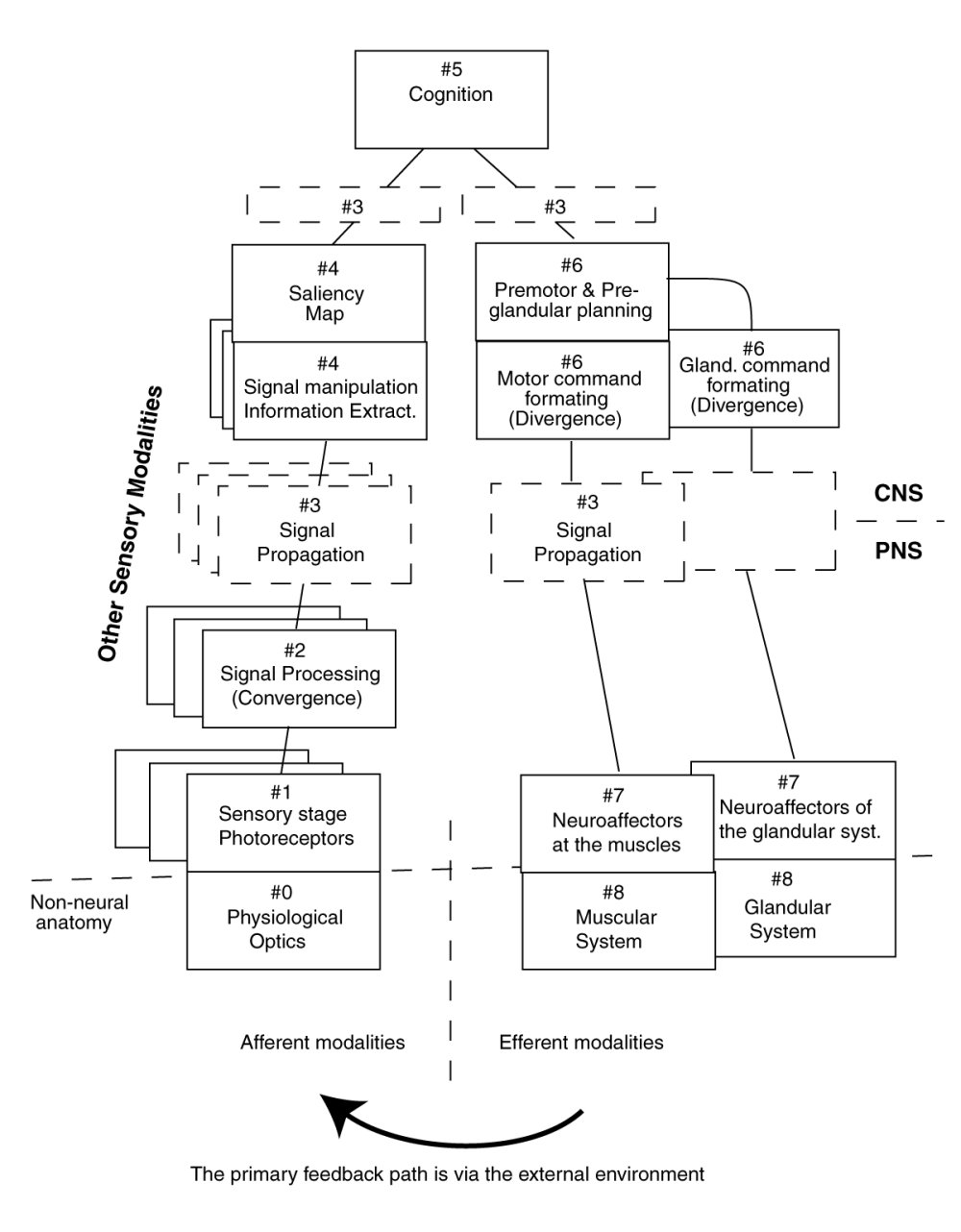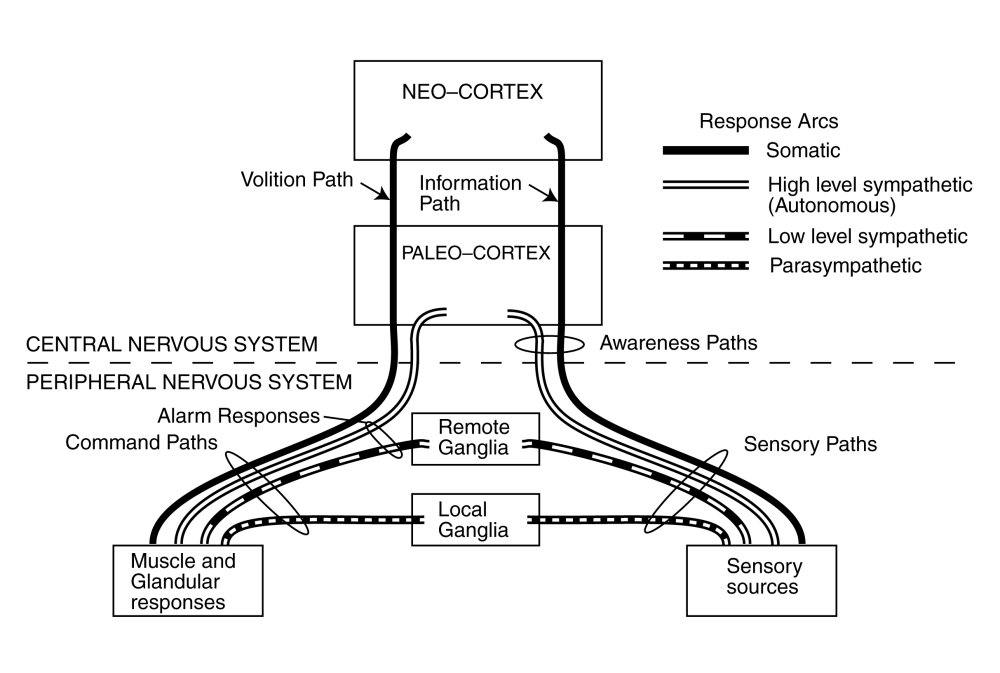
 | ... | BLOCK DIAGRAMS & OPERATING MODES |
... |
*** NO INDEX temporarily in header ***
The study of the neural system has long suffered from the lack of an organized functional framework (as opposed to the many gross anatomic schematics of various portions of the system). This has made it difficult to understand both the overall operations of the neural system and the detailed operation of individual neurons.
The following figure provides a framework for discussing the neural system of biology in detail. It describes the major functional areas of the neural system.
The neural system is defined beginning with the sensory function associated with the "receptor neurons" of the peripheral nervous system (PNS). These receptor neurons are typically followed by a signal processing function (also within the PNS) before the perceived signals are forwarded to the Central Nervous System (CNS) for further processing.
The complexity of the system is indicated by the multiple sensory modalities shown operating in parallel along the left side of the figure. These modalities all feed into a common set of engines within the CNS that operate in a complex mesh network.
The response portion of the neural system can be divided into two distinct portions, the motor subsystem associated with the skeletal-musculara, and the glandular subsystem which controls a variety of internal functions.
The figure highlights two features of the overall neural system. First, the system forms a large feedback loop that relies upon the external environment to provide the feedback path. Interestingly, this external environment includes both the environment outside the organism and the environment within the gastro-intestinal system passign through the organism. Second, whenever signals must be propagated more than a few millimeters, they are converted into phasic signals (represented by streams of action potentials) for more energy efficient transmission. Thus the function of signal propagation (stage 3) is found at multiple locations within the neural system.
Signal propagation using phasic signals (action potentials) is a development associated with, and diagnostic for, the Phylum Chordate. It is a key feature leading to the development of a central "brain" coordinating and controlling the neural activity of the organism.

Stage 1, encompasses the neural circuits involved in the detection of the stimulus and signal generation subsequent to that stimulus. This stage will end with the presentation of the signals at the pedicels of the sensory neurons.
Stage 2, consists of the neurons associated with signal processing and manipulation carried out between the pedicels and the encoding elements of the stage 3 ganglion neurons. Being a functional element in the signal processing stage, the synapses associated with the pedicels will be considered part of Stage 2. Similarly, the neurites of the ganglion cells are also key players in the signal processing of Stage 2.
Stage 3, includes those neurons involved in the signal projection circuits of the neural system. The signal projection function is highly developed and easily characterized in Chordata. It is used wherever it is necessary to transmit neural signals over significant distances (typically a millimeter or more). This includes both the efferent and afferent signal paths of the peripheral nervous system (PNS) and the paths within the brain, or central nervous system, (CNS). Further detailed discussion of stage 3 operations, including the coding of the signals, can be explored via the Reference below.
Stage 4 consists of all of the higher level signal manipulation associated with information extraction from the signals. It occurs subsequent to the arrival of signals at the brain from Stage 3. It is often useful to subdivide this stage to clarify the fundamental difference in the signal manipulation occurring within the thalamus from that occurring in the cerebellum and the cerebral cortex.
Stage 5 consists of “cognition,” information manipulation and volition instruction generation within the prefrontal cortex and monitored by the thalamic reticular nucleus (TRN) of the midbrain acting as gatekeeper.
Stage 6 consists of the premotor and motor areas of the cerebral cortex along with the motor portions of the cerebellum and the superior colliculus. This stage accepts volition instructions from the prefrontal cortex and generates adversive instructions and command signals responding to the volition instructions emanating from the prefrontal cortex. It also accepts alarm mode signals directly from the TRN and even from the stage 2 alarm circuits of the sensory modalities.
Stage 7 consists of the command implementation neurons. These include the muscle actuator neurons (end plates) and the secretory neurons.
The Central Nervous System is a highly complex mesh network of individual neural engines (typically incorporating more than four million neurons in each identifiable engine). These engines can be simultaneously interconnected in a variety of operating overlays. While the term mode has historically been associated with the individual sensory modalities of the PNS, the term is well suited to describe the operating overlays found within the CNS.
The nervous system of the higher animals is controlled by two distinct executives, the conscious executive found in the prefrontal cortex of the "new" brain (the neo-cortex or cerebral cortex), and the nonconscious executive represented by the thalamic reticular nucleus (TRN) of the "old" brain (the paleo-cortex)." Each of these executives are associated with the control of a vast array of functions. These functions can be associated with individual signaling paths (overlays) that may contain multiple processing engines. These overlays support individual operating modes within the CNS.
The nervous system, and the sensory neurons of stage 1 specifically, are always operative. However, accessing of the sensed information within the saliency map by the conscious executive of stage 5 may be suppressed at times. This suppression is probably a responsibility of the the TRN, the nonconscious executive within the paleo-cortex and stage 4.
The following definitions describe the major modes identified in this work. The first group are the major operating modes. These are AWARENESS, ALARM, ANALYSIS and COMMAND. These modes are functional in character and largely time invariant. This group is followed by two time sensitive overlays (modes) associated with attention, STANDBY & STARE.
The AWARENESS mode is shared among all but the very lowest phylogeny of animals. This mode provides the interpretive and cognitive centers of the animal with a multi-sensor description of the surrounding environment. It employs an earth-oriented (gravity-oriented) inertial framework that is not related or restricted to the field of view of the eyes of the animal. The interpretations placed in the saliency map based on this framework, are not "– topic" to the sensory mode. They are entirely symbolic but their location within the POT describes their associated receptive field.
The ALARM mode may be the primary mode of the neurological system. It is shared by all known animals (including those excluded from the awareness mode). The first order task of the alarm mode is to decide if the trajectory of an object in the environment will cause an imminent collision with the animal. If true, the general response is some degree of flight to escape potential threats. If not, the threat is considerably reduced. Failure to escape by flight can lead to a defensive posture. However, this posture does not appear to represent a separate functional mode.
The ANALYSIS mode is most common among the higher chordates and most optimized, both physiologically and programmatically, among humans. The mode is used to extract information from a scene (whether a visual, auditory or olfactory, etc. scene).
The COMMAND mode is involved primarily with the execution of changes in the external environment (from the subjects perspective) in response to sensory inputs. These responses are predominantly timely but may involve significant delay at the will of the conscious executive. The command mode signals are primarily low level and directed to particular neuro-affectors. They are an expansion of higher level signals that have passed through the cerebellum and/or superior colliculus.
The ANALYTICAL mode exhibits an unusual set of operating conditions tha tcan be associated with the subject of attention. They include the SLEEP state and the "normal" AWAKE state.
In the SLEEP state, the sensory modalities are still functional but operate at reduced performance. The seonsory modalities can be described as in the STANDBY mode. Dreaming is an example; the eyes are closed but the conscious executive continues to manipulate information (particularly imagery) much as if the eyes were open and functioning. During dreaming, The conscious executive of the neo-cortex continues to create instructions directed at the motor (muscle) system. However, these are largely interrupted by the nonconscious executive, the TRN.
Even when awake, the nervous system can enter a semiconscious mode involving an apparently fixed visual stare (day dreaming) and less than optimum operation of other sensory modalities. This will be described as the STARE mode. In both the standby and stare modes, the fine motion of the eyes defined as tremor continues.
Functionally, the efferent neural system is shown as consisting of two portions in the above figure, the skeletal-muscular portion and the glandular portion. Operationally, the efferent neural system has has been divided into somatic (volition) versus autonomous portions. The autonomous portion has been divided further into the sympathetic and parasympathetic portions. These portions can be considered operating overlays (or operating modes) when the same neuroaffectors appear in multiple descriptions. Alternately, these portions can be considered parallel subsystems of the major system when they employ separate neuroaffectors and operate in opposition to each other (in push-pull in engineering parlance).
In general, the somatic and autonomous portions share the same neuroaffectors and can be considered overlays or operating modes of a common neural sustrate. The sympathetic and parasympathetic portions frequently employ separate neuroaffector sets and can be considered separate subsystems of the efferent neural system. The following figure shows the complex arrangement of these operating modes and subsystems schematically.

Return to the website home page.
A paper discussing the Neural Architecture and Operating Modes of the Neural System more broadly is available. It describes the operation of the system in greater detail and introduces the subjects of attention and image information extraction (related to the visual modality). It provides approximately fifty citations supporting the concepts discussed.
More extensive background and additional citations can be found in Section 4.2 of Chapter 4, The Architecture of the neural system.